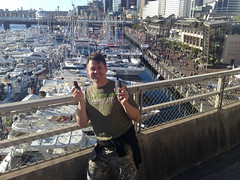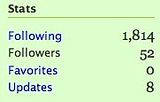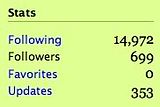It seems so easy to make global connections these days.
Tools like Twitter, Skype, podcasts, blogs and even good old fashioned email make it easy to build connections with others. But they also make it easy to overlook the fact that behind each tweet, IM or email there are real people. Although the online world has made us the most connected we have ever been, at the same time the sometimes faceless, disembodied nature of it can also allow us to be quite disconnected if we let it.
One of the things I’ve really enjoyed doing over the last couple of years is to take every opportunity to make real connections with the people behind the avatars. I remember the first time I bumped into Judy O’Connell at a meeting in Sydney… although I knew of HeyJude and had read her blog for a while there was still this sense of “wow… so you ARE real!” when I finally met her. Since then, I try to make a point of meeting other members of my online world in the real world whenever I can. It’s great to finally meet up with people you feel like you somehow know through reading their blogs or hearing them on podcasts or seeing their endless streams of tweets.
This week I had the pleasant experience of meeting up with Colin Jagoe, a passionate young edutech in Ontario Canada, and the story of how that meeting came about is pretty typical of how our PLNs can so easily cross the boundary between the virtual and the real worlds. Colin apparently follows my Twitter feed, so when I mentioned that I was coming to Canada over Christmas, he dm’ed me back to ask if I’d be interested in coming to a meeting of edutech leaders in his school district. He suggested it might be good to share some stuff about what we’re doing in Australia as a way to provide some additional food for thought for his district team. Naturally I jumped at the chance, so we emailed and Skyped back and forth to make the arrangements, and last Tuesday I headed out of Toronto and up to the Peterborough office of the Kawartha Pine Ridge District School Board to join their meeting and share some of the stuff I’ve been doing with the students back at PLC. We looked at some of the Year 3 Voicethreads, the Year 4 blogs, the Year 5 Podcasts and talked about the logistics and practicalities of running these sorts of projects. I shared the results of the recent PLC Mobile Phone Film Festival, an idea that also seemed to spark some possibilities for the Kawartha schools. We talked about Creative Commons and cellphones for learning and a bunch of other topics that came up, and it was wonderful to be able to share some of this with real live people in a real live space.
I had to laugh when Colin’s first words to me as we met in the foyer were “So you ARE real!”, exactly the words I used when I met HeyJude the first time. It’s good to finally meet people and put a real face to their avatar, and this experience goes to show just how easy it is to create global links between people… here was I, a teacher from Australia, talking with a group of Canadian educators about ideas that were relevant to both of us. It started as virtual (and there is certainly a great deal that can be done in a purely virtual environment, don’t get me wrong!) but it is amazing just how a few tweets, skypes and emails can take these virtual connections and make them real if that that’s what you want to do.
It got me thinking about some of the other real life connections I’ve been able to make over the last year or so, and it’s pretty amazing. I dug through my Flickr photostream and found quite a few snapshots that I’ve taken with other connected educators, so I made this little slideshow. (The new slideshow tool is Flickr is fabulous by the way!) There are many other wonderful educators I’ve met that I couldn’t find photos for… I don’t want to list names as I’m sure to overlook someone inadvertently, but my apologies if I’ve left you out!
Next week, I’ll have the great pleasure of meeting Sharon Peters when I’m in Montreal, something I’m very much looking forward to. Sharon and I have spent many hours over the last few years chatting over Skype and sharing ideas, and she has organised for her and I to present a 4 hour workshop on IWBs and Web 2.0 tools to school leaders in the Montreal independent school sector. Should be good fun!
Sharon and I have been in touch all week with last minute organisational bits and pieces for the workshop, but I’m sure that when we finally meet in person next week I’ll still have that same overwhelming sense of “so you ARE real!”

 Geocaching is a great way to combine a bit of fun technological geekery with some good old fashioned go-outside-and-get-some-fresh-air action.
Geocaching is a great way to combine a bit of fun technological geekery with some good old fashioned go-outside-and-get-some-fresh-air action.


